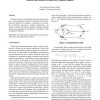3707 search results - page 138 / 742 » A Simple Technique for Self-Calibration |
EACL
2006
ACL Anthology
14 years 11 months ago
2006
ACL Anthology
We describe a method for discovering irregularities in temporal mood patterns appearing in a large corpus of blog posts, and labeling them with a natural language explanation. Sim...
113
click to vote
SNPD
2003
14 years 11 months ago
2003
The paper discusses simple functional constraint networks and a value propagation method for program construction. Structural synthesis of programs is described as an example of d...
108
click to vote
CCCG
2000
14 years 11 months ago
2000
We present a simple linear time algorithm for decoding Edgebreaker encoded triangle meshes in a single traversal. The Edgebreaker encoding technique, introduced in [5], encodes th...
SODA
2000
ACM
14 years 11 months ago
2000
ACM
In this note we describe a general technique for making treestructured dynamic dictionaries adapt to be competitive with the most efficient implementation, by using potential ener...
85
Voted
CGF
2006
14 years 10 months ago
2006
This paper presents a simple and efficient technique for synthesizing high-fidelity motions by attaching, or splicing, the upper-body action of one motion example to the lower-bod...

